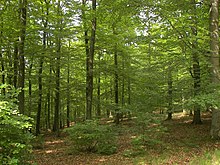High forest (silviculture)
Under Hochwald means a forest shape, in which the individual stems only from core growths arise. These grow to high individuals whose form and vitality in the trees Stock rash forests tends to be superior. A distinction is made between two forms of high forest in managed forests:
- the sudden high forest
- the plenter forest (here the concept of the field loses its meaning, since individual silvicultural activities such as education and end use are no longer carried out in isolation from one another, but are carried out simultaneously with each intervention)
The following types of farms are roughly differentiated based on the regeneration processes in the case of the high forest:
- Clear-cutting - all trees are removed, then mostly artificial regeneration , i.e. planting - if necessary, changing the tree species, sometimes after natural regeneration has emerged . A measure necessary for the cultivation of light tree species such as oak .
- Edging - in strips from one side against the main wind direction, progressive use and planting, possibly natural regeneration.
- Umbrella strike - gradual thinning of the stand, then natural regeneration and sometimes planting for species enrichment.
- Femelschlag - illumination of the smallest areas and later concentric expansion so that light shafts arise and natural regeneration takes place, possibly planting for species enrichment. After several years, renewed removal of old trees elsewhere, natural regeneration through the adjacent old trees, etc.
In the plenter forest, trees are removed from the trunk “from the thick end”. This predominantly natural regeneration process is well suited for shade tree species , such as many conifers. In the case of beech forests, this procedure is carried out as a rare exception on rich locations where planting is necessary for species enrichment.
The appropriate choice of the type of operation and the type of operation depends , in addition to the zeitgeist, on the existing and subsequently desired tree species, the local conditions and, last but not least, on the previous silvicultural treatment in recent decades.
Among the types of operation, a distinction is made between high forest, medium forest and coppice forest .
literature
- Richard B. Hilf : The forest. Forests and pastures in the past and present - Part One [Reprint]. Aula, Wiebelsheim 2003, ISBN 3-494-01331-4
- Ernst Röhrig , Norbert Bartsch , Burghard von Lüpke , Alfred Dengler (founder): Silviculture on an ecological basis . 7th, fully updated edition. Ulmer, Stuttgart (Hohenheim) 2006, 479 pages, ISBN 3-8252-8310-0 (UTB) or ISBN 3-8001-4595-2 (Ulmer)
- Hans Hausrath : History of German silviculture. From its beginnings to 1850 . Series of publications by the Institute for Forest Policy and Regional Planning at the University of Freiburg. Hochschulverlag, Freiburg im Breisgau 1982, ISBN 3-8107-6803-0
